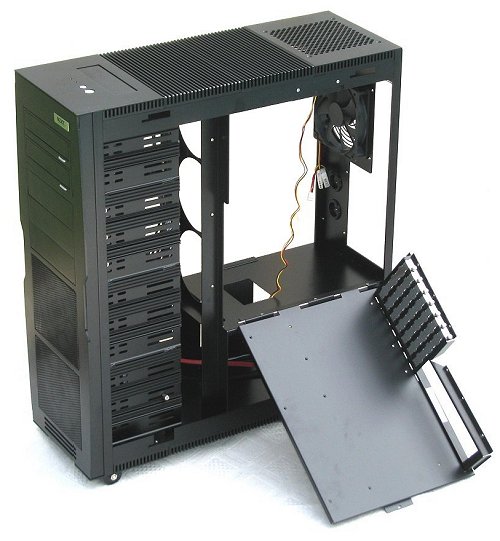Internal Design
The interior design of the Khaos is just as unusual as the exterior. The first thing I noticed is that for a full size ATX case, it appears to be a little crammed inside. This is largely due to the triple fan bracket which is mounted inside the case.
The fan bracket is not a bad feature per se, though if they are going to put it there they could at least have it loaded with three fans for your $400. The bracket itself is also extremely flimsy and will wobble all over the place with the slightest touch. In fact, the bracket alone makes working inside the Khaos a real pain, and if I were to use this case for my own machine, I would immediately take it out.


NZXT has done with a bottom mounted power supply design, which we first saw from Antec a few years ago, and today it seems like a popular choice. However, unlike many of the Antec cases I have seen, NZXT does not completely divide off the lower third of the case, so we are not sure what kind of impact this will have on air-flow.
Above the power supply enclosure is the motherboard tray, which is on a hinge, and with the right side door removed can be folded outside of the case making the installation of not only the motherboard, but also components such as the CPU heatsink much easier. It is worth noting that because the tray is on a hinge it tends to vibrate a lot, which could cause quite a lot of noise if the CPU fan, for example, was creating a small amount of vibration.



Something that we liked about the design are the 3.5" removable drive bays, which are actually connected to the front mounted 120mm blue LED fans. By simply removing two thumb screws these bays - each capable of supporting four drives - slide right out the front of the case. Although the drive bays are not screw-less, they are very easy to mount hardware in.

Internally the drive bays are lug welded together, which looks a little nasty, but serves the purpose I guess. All in all the Khaos can support eight 3.5" drives and five 5.25" drives, while there is room for two full size ATX power supplies and room to add three more internal fans using the triple fan bracket if you wished to do that. But in short, there is nothing different, out of the ordinary, or unique about the design of the Khaos internally.

Even the cooling setup is quite basic, though it is sufficient. Removing hot air from within the case are two rear mounted fans. There is a 120mm fan mounted at the rear of the case above the I/O panel, while the second is a 140mm top mounted fan, both featuring 3-pin and 4-pin power connectors. The front mounted blue LED 120mm fans look particularly good when active, and are designed to draw in cool air from outside the case.


The design also leaves plenty of room for users that want to install a water-cooling kit, especially if you only install a single power supply. On that note, given how much users are paying for this case you would think NZXT would have been a little more creative. For example, including an additional hard drive bay that can slot into the secondary power supply bracket while not in use.
Thankfully the interior is painted black like the exterior which looks very nice. On a high note the paint job on the Khaos is very well done and extremely scratch resistant. Taking a screwdriver to the paint work, it took quite a lot of digging to remove the paint.
